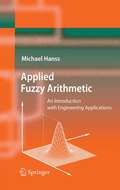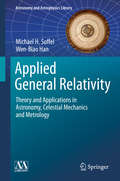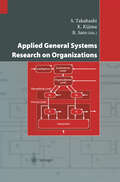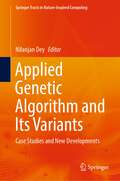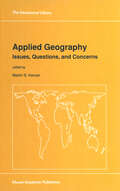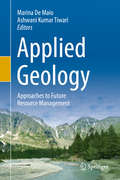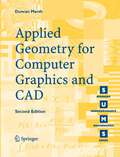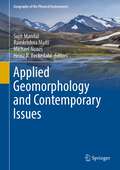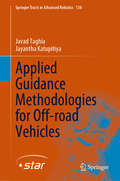- Table View
- List View
Applied Food Science and Engineering with Industrial Applications
by Cristóbal Noé Aguilar Elizabeth Carvajal-MillanApplied Food Science and Engineering with Industrial Applications highlights the latest advances and research in the interdisciplinary field of food engineering, emphasizing food science as well as quality assurance. The volume provides detailed technical and scientific background of technologies and their potential applications in food preservation. The volume’s broad perspective reflects the expertise of international and interdisciplinary engineers, drawing on that of food technologists, microbiologists, chemists, mechanical engineers, biochemists, geneticists, and others. The volume will be valuable and useful for researchers, scientists, and engineers, as well as for graduate students in this dynamic field. This book is a rich resource on recent research innovations in food science and engineering with industrial applications, presenting a practical, unique and challenging blend of principles and applications.
Applied Food Science and Engineering with Industrial Applications
by Cristóbal Noé Aguilar Elizabeth Carvajal-MillanApplied Food Science and Engineering with Industrial Applications highlights the latest advances and research in the interdisciplinary field of food engineering, emphasizing food science as well as quality assurance. The volume provides detailed technical and scientific background of technologies and their potential applications in food preservation. The volume’s broad perspective reflects the expertise of international and interdisciplinary engineers, drawing on that of food technologists, microbiologists, chemists, mechanical engineers, biochemists, geneticists, and others. The volume will be valuable and useful for researchers, scientists, and engineers, as well as for graduate students in this dynamic field. This book is a rich resource on recent research innovations in food science and engineering with industrial applications, presenting a practical, unique and challenging blend of principles and applications.
Applied Fourier Analysis: From Signal Processing to Medical Imaging
by Tim OlsonThe first of its kind, this focused textbook serves as a self-contained resource for teaching from scratch the fundamental mathematics of Fourier analysis and illustrating some of its most current, interesting applications, including medical imaging and radar processing. Developed by the author from extensive classroom teaching experience, it provides a breadth of theory that allows students to appreciate the utility of the subject, but at as accessible a depth as possible. With myriad applications included, this book can be adapted to a one or two semester course in Fourier Analysis or serve as the basis for independent study.Applied Fourier Analysis assumes no prior knowledge of analysis from its readers, and begins by making the transition from linear algebra to functional analysis. It goes on to cover basic Fourier series and Fourier transforms before delving into applications in sampling and interpolation theory, digital communications, radar processing, medical imaging, and heat and wave equations. For all applications, ample practice exercises are given throughout, with collections of more in-depth problems built up into exploratory chapter projects. Illuminating videos are available on Springer.com and Link.Springer.com that present animated visualizations of several concepts.The content of the book itself is limited to what students will need to deal with in these fields, and avoids spending undue time studying proofs or building toward more abstract concepts. The book is perhaps best suited for courses aimed at upper division undergraduates and early graduates in mathematics, electrical engineering, mechanical engineering, computer science, physics, and other natural sciences, but in general it is a highly valuable resource for introducing a broad range of students to Fourier analysis.
Applied Fractional Calculus in Identification and Control (Studies in Infrastructure and Control)
by Utkal Mehta Kishore Bingi Sahaj SaxenaThe book investigates the fractional calculus-based approaches and their benefits to adopting in complex real-time areas. Another objective is to provide initial solutions for new areas where fractional theory has yet to verify the expertise. The book focuses on the latest scientific interest and illustrates the basic idea of general fractional calculus with MATLAB codes. This book is ideal for researchers working on fractional calculus theory both in simulation and hardware. Researchers from academia and industry working or starting research in applied fractional calculus methods will find the book most useful. The scope of this book covers most of the theoretical and practical studies on linear and nonlinear systems using fractional-order integro-differential operators.
Applied Fuzzy Arithmetic: An Introduction with Engineering Applications
by Michael HanssFirst book that provides both theory and real world applications of fuzzy arithmetic in a comprehensive style. Provides a well-structured compendium that offers both a deeper knowledge about the theory of fuzzy arithmetic and an extensive view on its applications in the engineering sciences making it useful for graduate courses, researchers and engineers. Presents the basic definitions and fundamental principles of fuzzy arithmetic, derived from fuzzy set theory. Summarizes the state-of-the-art stage of fuzzy arithmetic, offers a comprehensive composition of different approaches including their benefits and drawbacks, and finally, and presents a completely new methodology of implementation of fuzzy arithmetic with particular emphasis on its subsequent application to real-world systems. Concentrates on the application of fuzzy arithmetic to the simulation, analysis and identification of systems with uncertain model parameters, as they appear in various disciplines of engineering science. Focuses on mechanical engineering, geotechnical engineering, biomedical engineering, and control engineering.
Applied Fuzzy Systems
by Toshiro Terano Kiyoji Asai Michio SugenoApplied Fuzzy Systems provides information pertinent to the fundamental aspects of fuzzy systems theory and its application. This book discusses the development of high-level artificial intelligence and information processing systems, as well as the realization of fuzzy computers. Organized into six chapters, this book begins with an overview of the fundamental problems addressed by fuzzy systems. This text then reviews standard computer logic or two-valued Boolean algebra. Other chapters consider bus scheduling, evaluation of structural reliability, applications of schema systems for decision-making, and processing of natural-language information and systems for medical diagnosis as examples of fuzzy expert systems. This book discusses as well a practical fuzzy expert system for durability evaluations of reinforced concrete slabs for bridges, along with an example of application. The final chapter deals with the important parts of the construction of fuzzy computers, their architecture, and the outlook for the future. This book is a valuable resource for engineers, mathematicians, technicians, and research workers.
Applied General Relativity: Theory and Applications in Astronomy, Celestial Mechanics and Metrology (Astronomy and Astrophysics Library)
by Michael H. Soffel Wen-Biao HanIn the late 20th and beginning 21st century high-precision astronomy, positioning and metrology strongly rely on general relativity. Supported by exercises and solutions this book offers graduate students and researchers entering those fields a self-contained and exhaustive but accessible treatment of applied general relativity. The book is written in a homogenous (graduate level textbook) style allowing the reader to understand the arguments step by step. It first introduces the mathematical and theoretical foundations of gravity theory and then concentrates on its general relativistic applications: clock rates, clock sychronization, establishment of time scales, astronomical references frames, relativistic astrometry, celestial mechanics and metrology. The authors present up-to-date relativistic models for applied techniques such as Satellite LASER Ranging (SLR), Lunar LASER Ranging (LLR), Globale Navigation Satellite Systems (GNSS), Very Large Baseline Interferometry (VLBI), radar measurements, gyroscopes and pulsar timing. A list of acronyms helps the reader keep an overview and a mathematical appendix provides required functions and terms.
Applied General Systems Research on Organizations
by S. Takahashi K. Kijima R. SatoDrastic changes of the societies in the new century require new paradigm in every area of social science. Organizations study is not exception. This book illustrates the cutting edge of organizations study beyond the traditional approaches in management science and general management theory. With an interdisciplinary approach emphasizing systemic properties of organizations such as interaction, hierarchy, network and emergence, it covers dynamic aspects of organizational learning and evolution as well as the decision making function and information processing process.
Applied Genetic Algorithm and Its Variants: Case Studies and New Developments (Springer Tracts in Nature-Inspired Computing)
by Nilanjan DeyThis book provides fundamental concepts related to various types of genetic algorithms and practical applications in various domains such as medical imaging, manufacturing, and engineering design. The book discusses genetic algorithms which are used to solve a variety of optimization problems. The genetic algorithms are demonstrated to offer reliable search in complex spaces. The book presents high-quality research work by academics and researchers which is useful for young researchers and students.
Applied Genomics of Foodborne Pathogens (Food Microbiology and Food Safety)
by Xiangyu Deng Henk C. den Bakker Rene S. HendriksenThis book provides a timely and thorough snapshot into the emerging and fast evolving area of applied genomics of foodborne pathogens. Driven by the drastic advance of whole genome shot gun sequencing (WGS) technologies, genomics applications are becoming increasingly valuable and even essential in studying, surveying and controlling foodborne microbial pathogens. The vast opportunities brought by this trend are often at odds with the lack of bioinformatics know-how among food safety and public health professionals, since such expertise is not part of a typical food microbiology curriculum and skill set. Further complicating the challenge is the large and ever evolving body of bioinformatics tools that can obfuscate newcomers to this area. Although reviews, tutorials and books are not in short supply in the fields of bioinformatics and genomics, until now there has not been a comprehensive and customized source of information designed for and accessible to microbiologists interested in applying cutting-edge genomics in food safety and public health research. This book fills this void with a well-selected collection of topics, case studies, and bioinformatics tools contributed by experts at the forefront of foodborne pathogen genomics research.
Applied Geography: Issues, Questions, and Concerns (GeoJournal Library #15)
by Martin S. KenzerThe completion of this collection took many months, and, for a variety of reason, required the assistance and/or indulgence of a number of individuals. First and foremost, I would like to thank Tim Hudson for his useful input and support at the outset of the project Likewise, I would like to thank Jesse O. McKee for providing a hospitable environment during my affiliation with the University of Southern Mississippi. At Louisiana State University I am grateful to Sam Hilliard and Carville Earle for their invaluable understanding. The book became part of the GeoJoumal Library as a result of Wolf Tietze's confidence in the topic, and because of Henri G. van Dorssen's (and Kluwer Academic Publishers') good nab.lre - despite numerous 'problems'. Curtis C. Roseman, and the remainder of the Geography Department at the University of Southern California (where I completed many last minute details for the volume), are to be thanked for the cordial and warm environ ment I received while a visitor in Los Angeles. Finally, no multi-authored collection reaches completion without the help of many patient contributors. This particular book suffered many set-backs along the way, so I am particularly grateful to the authors herein. They demonstrated their compassion and exceptional professionalism throughout, by never second-guessing my decisions, and by allowing me to remedy the set-backs in my own way. They were a pleasure to work with, and they should take pride in their achievements.
Applied Geology: Approaches to Future Resource Management
by Marina De Maio Ashwani Kumar TiwariThis book includes a careful selection of significant contributions from international experts that were presented at the 6th AIGA Conference “Applied Geology: Approaches to Future Resource Management” that was held in the Courmayeur, Aosta Valley, Italy, from 27 - 29 June 2018. The following 7 areas are the main themes covered in this volume: · Applied Geology · Hydrogeology · Geological Exploration (underground) · Slope Instability, · Natural Hazards, Risk Assessment and Management, · Geo-resources and Sustainable Development · Application of Remote Sensing and Geographical Information Systems (GIS) The authors, from academia, research and industry present the latest state of the practice, new technologies, innovative methods and sustainable management in the field of Applied and Environmental Geology. This carefully edited work will be of value to academia, professionals, scientists and decision makers.
Applied Geometry for Computer Graphics and CAD (Springer Undergraduate Mathematics Series)
by Duncan MarshFocusing on the manipulation and representation of geometrical objects, this book explores the application of geometry to computer graphics and computer-aided design (CAD). Over 300 exercises are included, some new to this edition, and many of which encourage the reader to implement the techniques and algorithms discussed through the use of a computer package with graphing and computer algebra capabilities. A dedicated website also offers further resources and useful links.
Applied Geomorphology and Contemporary Issues (Geography of the Physical Environment)
by Sujit Mandal Ramkrishna Maiti Michael Nones Heinz R. BeckedahlThe edited book deals with climate change and its response to river system which is one of the most burning issues of the Global environment. Due to urbanization and industrialization land degradation and resource depletion are happening and promoting livelihood challenges in the world which is reflected in the book too. The book addresses the construction of dams over large rivers and its possible consequences in the environment. Changes of the hydrology and sedimentology are to be addressed in the book. The climate change phenomena and associated geomorphic hazards and contemporary environmental issues such as sea level rise, coastal flood, drought, wind erosion, flood, soil erosion, landslide, depletion of ground water, coastal erosion etc. are elaborated in the book with suitable methods and techniques. So this edited book will contribute a lot to general to particular filed of studies and will help to geographers, geomorphologists, environmentalists, planners, policy makers and developers for studies and promoting regional plans and development.
Applied Geotechnics for Construction Projects, Volume 1: Soil and Experimental Data (pdf)
by Ammar DhouibGeotechnical engineering is now a fundamental component of construction projects. The first volume of this book therefore paves the way for the development of a lasting partnership between soil and foundations. Applied Geotechnics for Construction Projects 1 first defines, identifies and classifies soils, exploring their complexities and weaknesses, and then outlines the basic principles of stresses and strains that establish and develop within soils. The third chapter of the book introduces and develops methods of soil investigation in order to experimentally determine the geotechnical parameters that are useful in the design stage of construction projects. Each chapter of this first volume is illustrated with photographs of example construction sites and concludes with concrete examples of real projects. The result is a combination of geotechnical expertise and lessons learned from experience, both of which are highly valuable in the field of applied geotechnics for construction projects.
Applied Geotechnics for Construction Projects, Volume 2: Fundamental Principles of Soil Mechanics and the Role of Water
by Ammar DhouibGeotechnical engineering is now a fundamental component of construction projects. The second volume of this book addresses the fundamental principles of soil mechanics and the role of water in geotechnical projects and assessments. Applied Geotechnics for Construction Projects 2 outlines the hydraulic properties of soils and the basic concepts of water in soil, detailing the principles of permeability measurement tests and giving concrete test cases, and then goes on to outline the basic notions of soil mechanics as applied in geotechnics: from consolidation to short- and long-term notions via the swelling phenomena of clayey soils, soil shear strength and slope stability. The third chapter presents a comprehensive overview of geotechnical expertise using examples of concrete projects either with or without damage in the context of geotechnical construction works. Each chapter of this second volume provides concrete examples of applications to real projects and the rules and lessons we must remember. The result is a combination of geotechnical expertise and lessons learned from experience, both of which are highly valuable in the field of applied geotechnics for construction projects.
Applied Geotechnics for Construction Projects, Volume 2: Fundamental Principles of Soil Mechanics and the Role of Water
by Ammar DhouibGeotechnical engineering is now a fundamental component of construction projects. The second volume of this book addresses the fundamental principles of soil mechanics and the role of water in geotechnical projects and assessments. Applied Geotechnics for Construction Projects 2 outlines the hydraulic properties of soils and the basic concepts of water in soil, detailing the principles of permeability measurement tests and giving concrete test cases, and then goes on to outline the basic notions of soil mechanics as applied in geotechnics: from consolidation to short- and long-term notions via the swelling phenomena of clayey soils, soil shear strength and slope stability. The third chapter presents a comprehensive overview of geotechnical expertise using examples of concrete projects either with or without damage in the context of geotechnical construction works. Each chapter of this second volume provides concrete examples of applications to real projects and the rules and lessons we must remember. The result is a combination of geotechnical expertise and lessons learned from experience, both of which are highly valuable in the field of applied geotechnics for construction projects.
Applied Geotechnics for Construction Projects, Volume 3: Behavior and Design of Project Foundations and Eurocode Validation
by Ammar DhouibGeotechnical engineering is now a fundamental component of construction projects. The third volume of this book is its backbone, dedicated to foundations for civil and industrial construction projects. Applied Geotechnics for Construction Projects 3 first presents the basic theoretical principles and rules governing the designing and validation of foundations; shallow, semi-deep and deep, then presents real foundation projects with a detailed comparison of the approaches and methods of calculating foundations in relation to the reference systems and rules in force, closely compared to and validated by the Eurocodes. The third chapter presents examples of foundation projects, covering high-side building rafts, strip footings, piles and embankments, enriched by an unprecedented level of experience in the field of foundations for civil and industrial construction projects. It ends with examples of damage to foundations and practical appendices. Each chapter of this third volume is illustrated with photographs and measurements of construction sites and is built on both theory and experience in the field of foundations as a whole. The result is a combination of geotechnical expertise and lessons learned from experience, both of which are highly valuable in the field of applied geotechnics for construction projects.
Applied Geotechnics for Construction Projects, Volume 3: Behavior and Design of Project Foundations and Eurocode Validation
by Ammar DhouibApplied Geotechnics for Construction Projects, Volume 4: Retaining Structures, Soil Reinforcement and Improvement
by Ammar DhouibApplied Geotechnics for Construction Projects, Volume 4: Retaining Structures, Soil Reinforcement and Improvement
by Ammar DhouibGeotechnical engineering is now a fundamental component of construction projects. The fourth and final volume of this book presents a range of retaining structures, alongside soil reinforcement and improvement techniques and processes. Applied Geotechnics for Construction Projects 4 first presents the concept of thrust-fall, then goes on to examine the behavior of retaining structures and their design and justification methods. A variety of practical applications for retaining structures are then considered, covering gravity walls, sheet pile curtains, in advance shoring excavations and retaining diaphragm walls. The book goes on to study soil reinforcement and improvement techniques, a subject that the author has dedicated thirty-five years to researching and teaching: from reinforced earth, in situ soil nailing, micropiles, in situ soil compaction, stone columns and rigid inclusions to "soil-cement" and "lime cement" columns. This book ends with a comprehensive and practical discussion of the behavior of underground structures; covering the concepts of convergence-confinement, stress evolution and subsidence estimation. Each chapter of this fourth volume is illustrated with concrete examples and measurements of retaining structures, soil reinforcement and soil improvement from construction sites. The result is a combination of geotechnical expertise and lessons learned from experience, both of which are highly valuable in the field of applied geotechnics for construction projects.
Applied Graph Theory in Computer Vision and Pattern Recognition (Studies in Computational Intelligence #52)
by Abraham Kandel Horst Bunke Mark LastThis book presents novel graph-theoretic methods for complex computer vision and pattern recognition tasks. It presents the application of graph theory to low-level processing of digital images, presents graph-theoretic learning algorithms for high-level computer vision and pattern recognition applications, and provides detailed descriptions of several applications of graph-based methods to real-world pattern recognition tasks.
Applied Guidance Methodologies for Off-road Vehicles (Springer Tracts in Advanced Robotics #138)
by Javad Taghia Jayantha KatupitiyaThis book provides methodologies for designing and implementing guidance algorithms for autonomous vehicles. These algorithms make important decision regarding how to steer and drive a ground vehicle in order to safely stay on an intended path, thereby making the vehicle driverless. The design tools provided in this book enable the reader to develop highly practical and real-world implementable guidance algorithms that will deliver high-accuracy driving for field vehicles. (They are equally applicable for on-road vehicles.) The book covers a variety of vehicle types, including wheeled vehicles, tracked vehicles, wheeled and tracked vehicles towing trailers, and four-wheel-steer and four-wheel-drive vehicles. It also covers active trailers that are driven and steered. Vehicles used in agriculture, mining and road construction are subjected to unpredictable and significant disturbances. The robust control methodologies presented can successfully compensate for these disturbances, as confirmed by the experimental results presented. Though the majority of the methodologies presented are based on sliding-mode controllers, other robust control methodologies are also discussed. To help the reader decide which controller is best suited for his/her choice of vehicle, experimental results are presented in a comparative format.
Applied High-Speed Plate Penetration Dynamics (Solid Mechanics and Its Applications #132)
by Gabi Ben-Dor Anatoly Dubinsky Tov ElperinHigh-speed impact dynamics is of interest in the fundamental sciences, e.g., astrophysics and space sciences, and has a number of important applications in military technologies, homeland security and engineering. When compared with experiments or numerical simulations, analytical approaches in impact mechanics only seldom yield useful results. However, when successful, analytical approaches allow us to determine general laws that are not only important in themselves but also serve as benchmarks for subsequent numerical simulations and experiments. The main goal of this monograph is to demonstrate the potential and effectiveness of analytical methods in applied high-speed penetration mechanics for two classes of problem. The first class of problem is shape optimization of impactors penetrating into ductile, concrete and some composite media. The second class of problem comprises investigation of ballistic properties and optimization of multi-layered shields, including spaced and two-component ceramic shields. Despite the massive use of mathematical techniques, the obtained results have a clear engineering meaning and are presented in an easy-to-use form. One of the chapters is devoted solely to some common approximate models, and this is the first time that a comprehensive description of the localized impactor/medium interaction approach is given. In the monograph the authors present systematically their theoretical results in the field of high-speed impact dynamics obtained during the last decade which only partially appeared in scientific journals and conferences proceedings.



